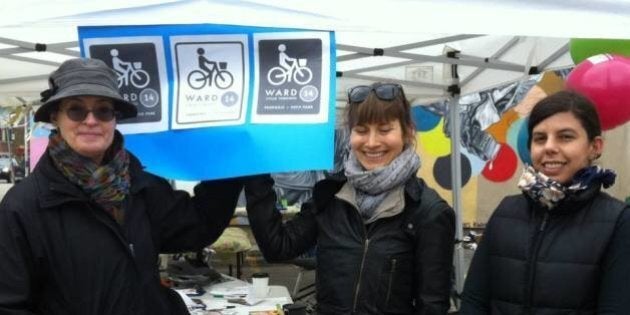
"When I first moved to Toronto, I considered myself to be a cyclist, but not a cycling advocate."
It was experiences of feeling unsafe and marginalized on Toronto's chaotic streets that led Laura Pin to start volunteering with Cycle TO, a member-supported organization that advocates for a healthy, safe, cycling-friendly city for all.
Nowadays, Laura proudly identifies as a cycling advocate, serving as both the co-founder and current co-captain of the Cycle TO Ward 14 Advocacy Group, which brings together energetic, passionate community residents to promote and advocate for cycling in their community.
After successfully pushing for bike lanes to be installed in her neighborhood, Laura walks us through the step she took to make the community change happen.
Step 1: Identify the Problem
Laura notes that while her neighborhood of Parkdale/High Park "has one of the highest concentration of bike commuters in the city, it has very little infrastructure to support these cyclists." The lack of bike lanes in the area left cyclists with limited options: either battle the traffic on Queen or King, or meander through disconnected one-way neighborhood streets, sometimes against the flow of traffic. The result? Unsafe conditions that could lead to collisions.
Step 2: Understand the Problem
Laura and her Ward 14 cycling advocacy group began digging to try and understand why there were so few bike lanes in the neighborhood. They discovered that there was a municipal plan for the area that recommended a series of contraflow bike lanes (bike lanes on quiet residential streets that flow in the opposite direction of traffic), but that the plan had never been implemented.
They then turned their attention to uncovering the reasons behind the government inaction. Through meetings with staff at the City of Toronto, they learned that the city did not want to build any new contraflow bike lanes (even though several had already been instituted) because there was some ambiguous language in the Ontario Transportation Act about whether contraflow bike lanes were legal in the city.
Step 3: Show Up and Be Heard
Once they understood the root of the problem, Laura says, the advocacy group teamed up with the staff at Cycle TO and began to "talk to absolutely everyone – our city councilor, our MPP, city of Toronto staff," to discuss the importance of contraflow bike lanes in their community and to brainstorm how to make them happen. By educating and raising awareness amongst their elected officials, the group was able to build political support.
In 2014, a major opportunity arose: The Ontario Transportation Act was opened up for amendments.The Ward 14 Advocacy Group and CycleTO HQ jumped on this chance to have their voice heard. "We made sure to be at those public consultations and participate in the dialogue," Laura explained, in order to educate policy makers and push for them to clarify the language about contraflow bike lanes in the Transportation Act.
Step 4: Celebrate your Victories!
After successfully advocating for the Ontario Transportation Act to change its language to allow contraflow bike lanes in the city, the advocacy group continued to meet with municipal politicians and staff to ensure the bike lane plan was actually implemented in a timely manner. Parkdale/High Park welcomed its first contraflow bike lane into the community on Fermanagh Avenue and additional contraflow bike lanes are scheduled to be built in summer 2015.
Step 5: Reflect on Lessons Learned
Laura suggests that when it comes to meeting with elected officials and government staff, be sure to do your homework beforehand. "Confidence goes a long way. You know your stuff. Don't psyche yourself out! You have something important to say."
For anyone trying to make a change in their community, Laura recommends connecting with the local groups in your neighborhood. Most communities have resident associations and other established advocacy groups who can offer support and help navigate the system. "The most significant thing is to get organized. It’s not just about policy change; it's about building a sense of community and bringing people together."
This article was first published on the WiToPoli blog. It's part of a new WiTOPoli series of How-To posts with women who have made change in their communities by working with (and sometimes fighting against) the institutions that make our city work. These women inspire us and remind us that though the challenges to having our voices heard are many, they are most certainly not insurmountable.
ALSO ON HUFFPOST:
